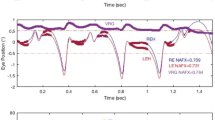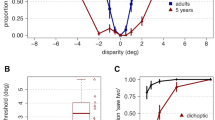Summary
Visual fields of ten cats which had one or both eyes rotated at 8 days of age were measured by two forms of perimetry and compared to visual fields of two normal cats and of four cats with monocular rotations at 16 days, 3 months or 6 months of age. All animals showed excellent localization of visual stimuli and responded to the actual location of stimuli in space rather than to the retinal locus normally associated with that location. In cats with monocular rotations, the field of the normal eye was always normal, extending from 90 ° ipsilateral to 30 ° contralateral. Cats with rotations of one eye at 3 or 6 months of age had essentially normal fields in the rotated eye as well, while cats with surgery at 8 or 16 days had restricted horizontal fields. They responded only to stimuli in the ipsilateral hemifield; they were blind in the contralateral hemifield. Their superior and inferior visual fields were normal. The field deficits related consistently to visual field coordinates and not to the angle or direction of rotation. In cats with binocular rotations the visual field of at least one eye extended across the midline. Thus, the extent of the field depended upon sensorimotor experiences of the cat both before and after surgery. It is argued that these monocular field deficits have a central origin, not a retinal one.
When tested with both eyes open, seven of 14 experimental animals did not respond throughout the visual field seen by each eye alone. The total visual field with both eyes open was less than the sum of the two monocular fields; greatest losses were most pronounced in the extreme periphery of the field ipsilateral to the rotated eye. Since changes in eye position (e.g., convergence during bincocular viewing) were not observed, it is suggested that the binocular losses indicate suppression of the deviated eye which has a central origin.
All animals were tested for visual following, visually-triggered extension (placing), and visually-guided reaching. Cats which had been routinely encouraged to use the rotated eye(s) by occlusion of the other eye showed skilful performance within a few weeks after surgery as previously reported by Peck and Crewther (1975), Mitchell et al. (1976) and others. In contrast, two cats reared with both eyes open after unilateral rotation in infancy were profoundly handicapped, as previously reported by Yinon (1975, 1976).
Similar content being viewed by others
References
Blakemore C, Van Sluyters RC, Peck CK, Hein A (1975) Development of cat visual cortex following rotation of one eye. Nature 257: 584–586
Crewther SG, Crewther DP, Peck CK (1977) Maintained binocularity in kittens raised with both eyes open. ARVO (Abstracts) p 269
Crewther SG, Crewther DP, Peck CK, Pettigrew JD (1980) The visual cortical effects of rearing cats with monocular or binocular cyclotorsion. J Neurophysiol 44: 97–118
Duke-Elder S, Wybar K (1973) Ocular motility and strabismus. System of ophthalmology, vol VI. Kimpton, London
Elberger AJ (1979) The role of the corpus callosum in the development of interocular eye alignment and the organization of the visual field in the cat. Exp Brain Res 36: 71–85
Gordon B, Moran J, Presson J (1979a) Visual fields of cats reared with one eye rotated. Brain Res 174: 167–171
Gordon B, Moran J, Presson J (1979b) Visual field deficits in cats with one eye rotated. Abstr Soc Neurosci 5: 626
Granit R (1977) The purposive brain. MIT Press, Cambridge, MA, pp 36–50
Hecaen H, Alberg ML (1978) Human neuropsychology. Wiley, New York
Hein A, Held R (1967) Dissociation of visual placing into elicited and guided components. Science 158: 390–392
Heitländer H, Hoffman KP (1978) The visual field of monocularly deprived cats after late closure or enucleation of the nondeprived eye. Brain Res 145: 153–160
Hubel DH, Wiesel TN (1970) The period of susceptibility to the physiological effects of unilateral eye closure in kittens. J Physiol (Lond) 206: 419–436
Hughes A (1976) A supplement to the cat schematic eye. Vision Res 16: 149–154
Ikeda H, Jacobson SG (1977) Nasal field loss in cats reared with convergent squint. Behavioural studies. J Physiol (Lond) 270: 367–381
Jacobson SG, Ikeda H (1979) Behavioural studies of spatial vision in cats reared with convergent squint. Is amblyopia due to arrest of development? Exp Brain Res 34: 11–26
Kalil R (1978) Dark rearing in the cat. Effects on visuomotor behavior and cell growth in the lateral geniculate nucleus. J Comp Neurol 178: 451–468
Mitchell DE, Giffin F, Muir D, Blakemore C, Van Sluyters RC (1976) Behavioral compensation of cats after early rotation of one eye. Exp Brain Res 25: 109–113
Mitchell DM, Griffin F, Wilkinson F, Anderson P, Smith ML (1976) Visual resolution in young kittens. Vision Res 16: 363–366
Olson C, Freeman RD (1978) Eye alignment in cats. Nature 271: 446–447
Orem J, Schlag-Rey M, Schlag J (1973) Unilateral visual neglect and thalamic intralaminar lesions in the cat. Exp Neurol 40: 784–797
Peck CK, Crewther SG (1975) Perceptual effects of surgical rotation of the eye in kittens. Brain Res 99: 213–219
Peck CK, Crewther SG, Barber G, Johannsen CJ (1979) Pattern discrimination and visuomotor behavior following rotation of one or both eyes in kittens and in adult cats. Exp Brain Res 34: 401–418
Peck CK, Schlag-Rey M, Schlag J (1980) Visuo-oculomotor properties of cells in the superior colliculus of the alert cat. J Comp Neurol (in press)
Schlag J, Schlag-Rey M (1977) Visuomotor properties of cells in cat thalamic internal medullary lamina. In: Baker R, Berthoz A (eds) Control of gaze by brain stem neurons. Elsevier Press, Amsterdam, pp 453–462
Schlag J, Schlag-Rey M, Peck CK, Joseph JP (1980) Thalamic neurons detecting the position of visual targets in space. Exp Brain Res (in press)
Sherman SM (1972) Development of interocular alignment in cats. Brain Res 37: 187–203
Sherman SM (1973) Visual field defects in monocularly and binocularly deprived cats. Brain Res 49: 25–45
Sherman SM (1974) Permanence of visual perimetry defects in monocularly and binocularly deprived cats. Brain Res 73: 491–501
Sherman SM (1977a) The effect of superior colliculus lesions upon the visual fields of cats with cortical ablations. J Comp Neurol 172: 211–230
Sherman SM (1977b) The effect of cortical and tectal lesions on the visual fields of binocularly deprived cats. J Comp Neurol 172: 231–246
Sherman SM, Sprague JM (1979) Effects of visual cortex lesions upon the visual fields of monocularly deprived cats. J Comp Neurol 188: 291–312
Simoni A, Sprague JM (1976) Parimetric analysis of binocular and monocular visual fields in Siamese cats. Brain Res 111: 189–196
Sperry RW (1943) Effect of 180 degree rotation of the retinal field on visuomotor coordination. J Exp Zool 92: 263–279
Sprague JM, Levy J, DiBernardino A, Berlucchi G (1978) Visual cortical areas mediating from discrimination in the cat. J Comp Neurol 172: 441–488
Sprague JM, Meikle TH Jr (1965) The role of the superior colliculus in visually guided behavior. Exp Neurol 11: 115–146
Timney B, Peck CK (1979) Visual acuity in cats following surgical rotation of one or both eyes. Abstr Soc Neurosci 5: 811
Timney B, Peck CK (in prep.) Visual acuity in cats following surgical rotation of one or both eyes
Toga AW, Layton BS, Horenstein S (1979) Visually directed behavior is influenced by the posterior ectosylvain gyrus in the cat. Brain Res 178: 606–608
Tumosa N, Tieman SB, Hirsch HVB (1980) Unequal alternating monocular deprivation causes asymmetric visual fields in cats. Science 208: 421–423
Tusa RJ, Palmer LA, Rosenquist AC (1978) Retinotopic organization of area 17 (striate cortex) in the cat. J Comp Neurol 177: 213–236
Van Hof-Van Duin J (1976) Development of visuomotor behavior in normal and dark-reared cats. Brain Res 104: 233–241
Van Hof-Van Duin J (1977) Visual field measurements in monocularly deprived and normal cats. Exp Brain Res 30: 353–368
van Grunau MW (1979) The role of maturation and visual experience in the development of eye alignment in cats. Exp Brain Res 37: 41–47
Wilkinson FE (1980) Reversal of the behavioral effects of monocular deprivation as a function of age in the kitten. Behav Brain Res 1: 101–123
Yinon U (1975) Eye rotation in developing kittens: the effect on ocular dominance and receptive field organization of cortical cells. Exp Brain Res 34: 215–218
Yinon U (1976) Eye rotation surgically induced in cats modifies properties of cortical neurons. Exp Neurol 51: 603–627
Author information
Authors and Affiliations
Additional information
This research was supported by Grant NS 14116 from the US Public Health Service
Rights and permissions
About this article
Cite this article
Peck, C.K., Barber, G., Pilsecker, C.E. et al. Visual field deficits in cats reared with cyclodeviations of the eyes. Exp Brain Res 41, 61–74 (1980). https://doi.org/10.1007/BF00236680
Received:
Issue Date:
DOI: https://doi.org/10.1007/BF00236680




